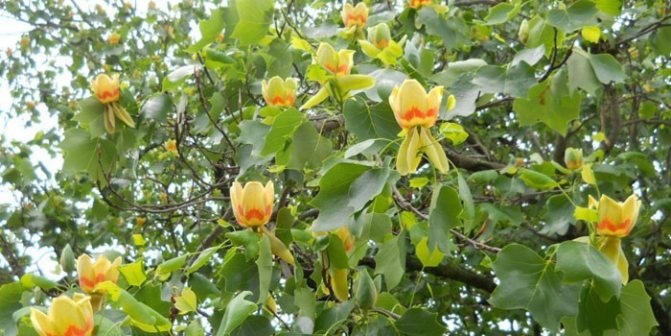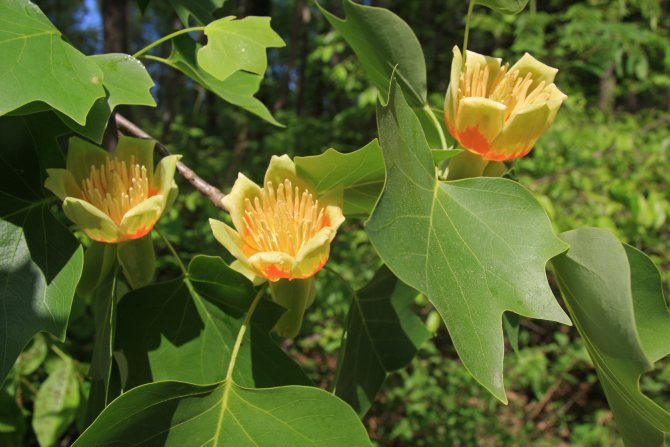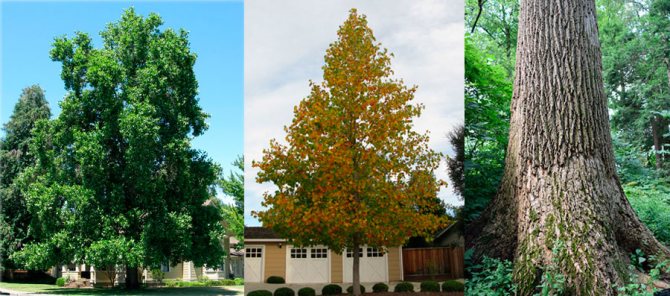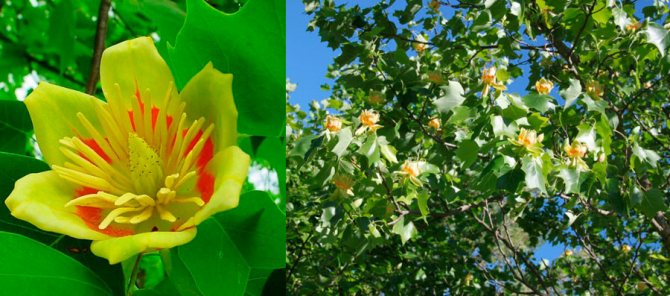5 Rating 5.00
Liriodendron - tulip tree - 5.0 out of 5 based on 3 votes
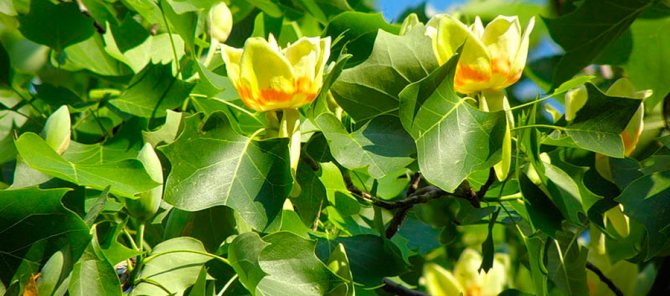
Tulips are not only flowers in flower beds and vases, but three or four exotic trees near your home. A beautiful name for the tree, and one of the names in Latin also sounds musical and poetic - liriodendron.
Features of growing a tulip tree at home
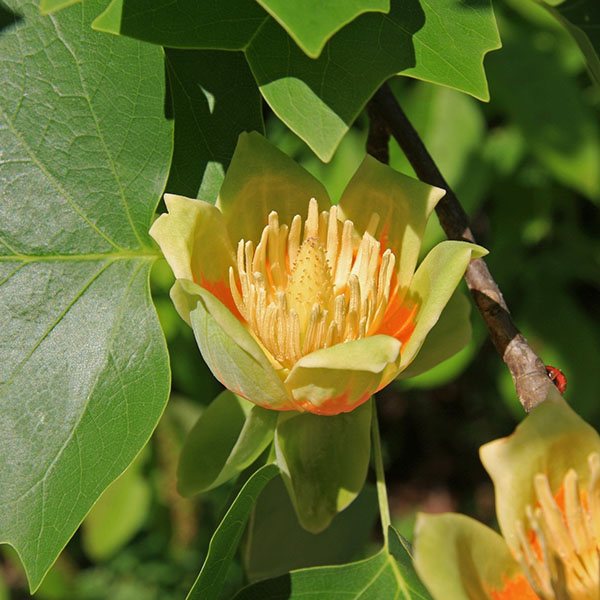

The first settlers who reached the shores of North America could not help but notice tall trees with unusual leaves and flowers, shaped like spring tulips. Unsurprisingly, the plant was named the tulip tree or Liriodendron tulipifera.
Today liriodendrons are known not only in their homeland. Tall trees with a lush crown can also be found in South American countries, on the shores of Australia, in southern Africa and in Europe. Europeans managed to domesticate a thermophilic culture and grow tulip trees even in Norway.
In our country, comfortable conditions for liridendrons have developed in the Black Sea subtropics, where trees adorn the streets and parks of Sochi and nearby resort towns.
Interest in the plant is increasing due to the appearance of varieties with variegated and golden foliage.
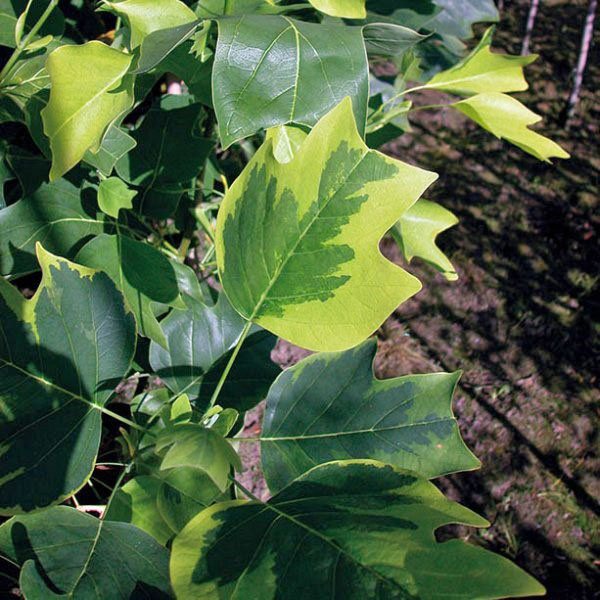

Tips for novice growers
When planning to grow a tulip tree in your garden, you need to determine the right time to plant. Most experienced flower growers perform the action in the spring, when the soil warms up enough. If the purchased seedling has an open rhizome, then planting should be started as soon as possible.
First you need to dip the roots in liquid with water and keep them there for 3-3.5 hours. Seedlings placed in a shipping container are stored for much longer. The main thing is to avoid stagnant moisture and an excess of limestone soil. Also, you should not plant a tree in soil with high acidity and high salt content.
It will be useful for a novice florist to pay attention to a number of recommendations:
- It is not advisable to grow a crop with frequent travel, business trips and prolonged absence from home.
- As soon as symptoms of a dangerous disease or pests appear on the tree, it is necessary to carry out a comprehensive treatment with a special composition.
- It is important to regularly monitor the state of the culture, effectively fixing problems and changing conditions of detention.
- It is recommended to keep the liriodendron away from pets, as they can chew on the leaves and lead to its death.
Description of the tulip tree liriodendron
Liriodendron is a large deciduous tree, capable of growing up to 35-50 meters in favorable conditions. The plant has a straight, powerful trunk covered with light gray-green bark. As they mature, the bark of trees turns from smooth into relief, covered with cracks dividing the surface into diamond-shaped areas. The brown bark on the branches has a noticeable waxy bloom. The wood of the tulip tree shown in the photo has a slight sweetish aroma.
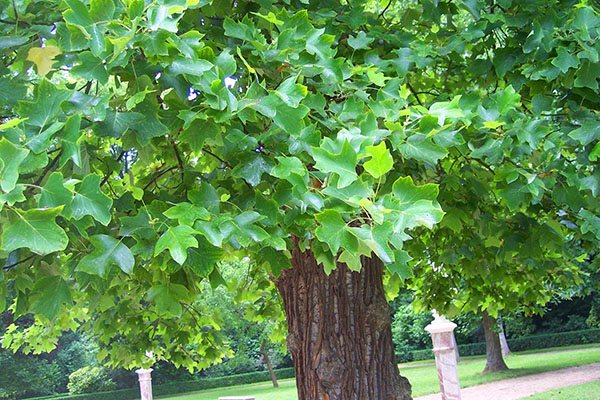

One of the adornments of liriodendron is wide lyre-shaped leaves on long petioles. The length of the leaf plate can reach 15–20 cm. Moreover, not only the shape, but also the color of the leaves is quite remarkable.From spring to the onset of autumn, they are painted in light green tones, and then first yellow, and later brown shades appear in the colors.
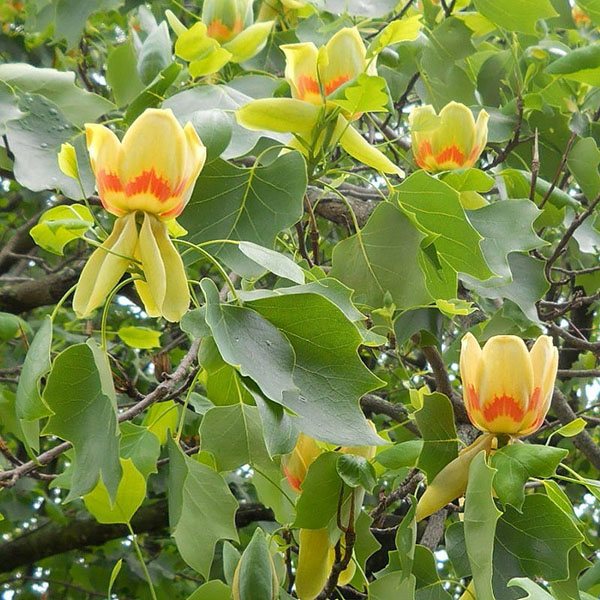

Flowers with a diameter of 6 to 10 cm resemble a tulip, during dissolution they pour a fresh cucumber aroma around the powerful crown and surprise with an original combination of greenish, yellowish, white and orange colors on the corolla.
At the time of mass flowering, the tulip tree liriodendron, like other plants related to magnolias, attracts many insects that willingly collect the nectar of the plant and pollinate its flowers.
In nature, liriodendron grows in areas with a rich humus, aerated soil, from which the powerful roots of the tree easily receive moisture and nutrition. The abundance of organic matter, regular watering and looseness of the soil are important conditions for the active growth and flowering of the crop. Although the seedlings take root on sandstones and clay, one cannot expect success without additional care, loosening and the introduction of organic matter. During dry months, especially young specimens of tulip trees are in dire need of watering.
Botanical description
Liriodendron is a large deciduous plant with a taproot system. Adults reach a height of more than 50 m.The crown width sometimes exceeds 1.5 m.
The trunks are massive, straight, without branching, have a greenish-gray smooth bark. With age, it becomes covered with frequent shallow grooves. Lateral shoots are located at an acute angle, far from the trunk. Young branches are brownish, smooth, covered with a thin waxy coating. Trees from the first years of life have a neat pyramidal crown. With age, it expands, becomes spreading.
Lyran leaves are large, four-lobed, with a notched apex... Their size reaches 20 cm in length and 14 cm in width. The surface is smooth, with fine feathery veins. On the branches, they are located alternately, hanging on 7-centimeter cuttings. Leaves are light green, sometimes with bright yellow stripes.
Liriodendron flowers are single, regular cupped, 6–8 cm in size. They look like tulip buds. The petals of the corolla are slightly elongated, with even edges, the lower ones are bent down, the upper ones are raised. The color of the flowers is pale yellow, cream in some varieties. At the base, the petals are greenish, in the middle they have a bright orange edging. Stamens are numerous, elongated, yellow.
The leaves and flowers of the tulip tree emit a light, cucumber-like, sweetish aroma.
Brown cone-shaped fruits about 5 cm in diameter are formed in place of wilting flowers, have a wide base and numerous lionfish with seeds. After ripening, they break off and are carried by the wind, sometimes remain on the branches until the next spring.
In its natural environment, the tulip tree prefers to grow on drained, breathable soils, sufficiently nutritious, with a high humus content. Lyran's lifespan reaches 450-500 years.
The high decorative qualities of the tulip tree were the reason for its introduction to Europe. Initially, they were planted only in the subtropics, then they began to grow in temperate latitudes. Most specimens tolerate frosts down to -35 ° C, mature trees are quite drought-resistant.
Growing a tulip tree
Of course, it is impossible to grow a tulip tree at home. However, strong seedlings from seeds can only be obtained by the seedling method.
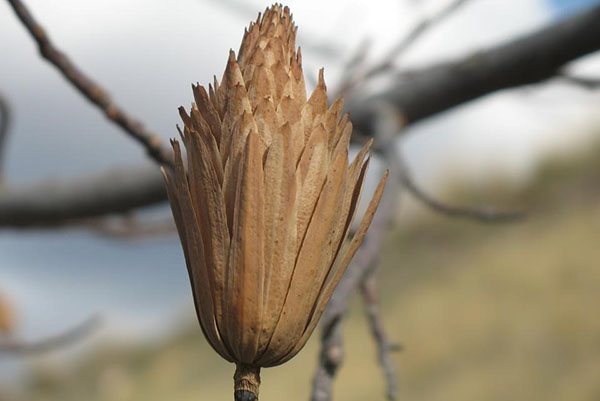

After pollination, loose cones form in place of flowers, which open in late autumn, scattering large seeds. In nature, they, falling to the ground, undergo natural stratification, and the germination process begins only after a year. Similar conditions for tulip tree seeds are created at home.
Since the seeds of liriodendron outside the soil quickly lose their germination, you need to acquire the most fresh material for sowing.
Sowing is carried out before winter to a depth of one and a half centimeters. At first, a universal soil mixture based on equal parts is suitable for growing a tulip tree:
When the soil is leveled and slightly compacted, the crops are watered and mulched. In this form, the container is exposed to the cold or placed in the refrigerator. In winter, the container with seeds must be covered with snow; during thaws and in summer, the soil must be watered so that the earth does not turn out to be completely dry.


Those wishing to grow a tulip tree will have to be patient. Seedlings appear only one and a half years after incorporation into the ground. But young sprouts don't disappoint. They are rapidly gaining strength, becoming stronger and stronger.
If purchased seeds were used for sowing, it is better to harden the seedlings before being taken out into the open ground. A month before transplanting, the plants gradually begin to accustom them to the outdoors, increasing the "walk" time every day.


The hardened plants are transferred to open ground, where the seedlings need simple but regular maintenance, including:
- moderate but frequent watering;
- weeding the trunk circle;
- spring and summer feeding of a young seedling;
- mulching the soil to retain moisture vital to the tree.
The liriodendron tulip tree blooms in May and June. For the first time, the plant forms flower buds at the age of 7-10 years, and then blooms regularly.


The decorativeness of the tree was appreciated not only by gardeners, but also by bonsai lovers. Miniature compositions based on this species are interesting at any time of the year and, due to the low growth rate, already a few years after the start of formation, they can demonstrate the quality of the master's work.
Landing
The soil should be fertile and loose. It is necessary to add black soil to the depleted soil, dilute too heavy clay soil with peat and sand. The acidity of the soil does not matter, but lyriodendrons do not tolerate a large amount of lime in the ground.


Planting is done in the spring, before the buds bloom.... This should be done in the ground heated to 12 ° C. The hole must be dug in a few days. Its volume should exceed the diameter of the earthen clod of the seedling by 2 times. If you plan to plant several specimens, the holes are dug at a distance of 5 m from each other. A layer of drainage from small stones is laid out at the bottom of the pits, a mixture of soil and complex mineral dressing is poured on top.
The root of the seedling is removed from the container together with an earthen lump.... It is recommended to moisten it beforehand. When placing the plant in the soil, the root collar should be flush with the surface. The earth is carefully compacted and watered. 1 tree should have about 15 liters of water. The trunk circle is mulched with peat, last year's grass or leaves with a layer of at least 8 cm. This will serve as a good protection against drying out and cracking of the soil.
This plant is rarely grown by seeds.... Sprouts sometimes appear after 2 years. Given the rapid loss of germination, they can not be expected at all. The stratified seeds are placed in containers with a soil mixture of garden soil, sand and peat to a depth of 1 cm. It will take several months to moisten the soil and weed the weeds. In the summer, it is advisable to take out the seating boxes to fresh air. When the emerging seedlings reach 30 cm, they are moved into open ground.
It is important to remember that the tulip tree does not tolerate transplanting, because its roots break easily under mechanical stress.


Tulip (tulip) tree liriodendron magnolia
The tulip tree (otherwise it is called the liriodendron, the magnolia tulip tree or the tulip liriodendron) is not for nothing that gardeners and florists are interested in.And it is not for nothing that it appears more and more often in the best modern gardens and alleys.
It is a unique and stunning plant of its kind that can beautify any garden.
Its special properties include the fact that this plant is able to grow literally in any conditions, even overcoming the winter temperature up to minus 30 degrees.
It is also a long-lived plant., which can overcome the milestone of five hundred years. In one year, liriodendron is able to grow one meter and even slightly higher. During the flowering period, flowers of amazing, fantastic beauty begin to appear on it. They are of an interesting shape, as if drawn or cut out of thin paper. Its flowers are large, the size can reach about seven centimeters. They look amazing on a long green and thin stem, adjoining branches along its entire length.
Diseases and pests
Tulip liriodendron is considered one of the best park trees in the world, not only for its decorative effect, but also for its resistance to diseases and pests, immunity to gas, soot and other environmental pollutants.
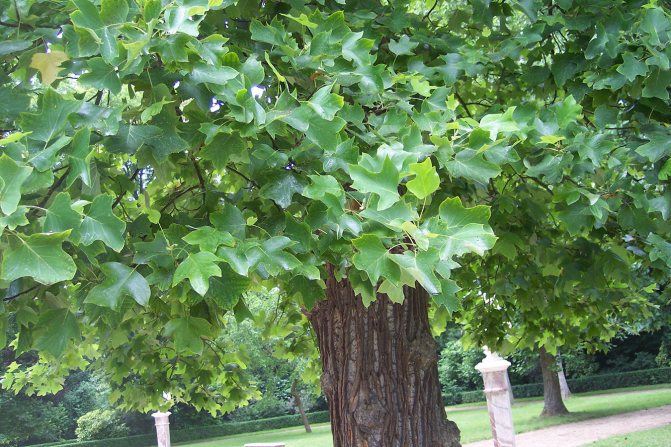

Problems in the form of fungal diseases arise with crowded close planting in high humidity conditions. Lack of watering leads to drying out of the tips of the leaves, and a lack of nutrients leads to a change in their color.
Growing places
Since the tulip tree is very resistant to various unfavorable climatic conditions, it can grow in large areas, while its natural and native habitat is located in areas with a temperate climate. The tree's habitat is very extensive: plantings of the tulip tree are found in strips ranging from the Norwegian coast from the northern part to the southern latitudes of Chile, South Africa, Peru, and so on.
Homeland Liriodendron – North America, however, its marked resistance to temperature extremes suggests that the tulip liriodendron is of African origin. Tulip magnolia adapts well to almost all climatic zones. It takes root well literally in any soil, does not in the least conflict with plants growing nearby.
Where grows
When deciding to purchase seedlings of beautifully flowering deciduous tulip plants that take root in moist but well-drained soils, find out where they grow. The plant itself is native to eastern North America. Another species (Liriodendron chinense) is found more naturally in Vietnam and southern China.
This large deciduous tree with brown branches in its plantations spreads widely from the coast of Norway in the north to countries in the south such as Peru, Chile, South Africa, etc. It should be emphasized that when artificially cultivating tulip liriodendron far from the natural place of growth, it does not show aggression towards other representatives of the flora growing nearby.
Liriodendron tulip in the suburbs
A tulip plant, with the right attitude, can be acclimatized in humid conditions. Today, the species is being cultivated even in the Moscow region, because it is frost-resistant. The leaves of an exotic plant resemble a lyre, and the first flowering in most cases occurs at the age of 25, although flowers sometimes appear even at the age of 6-7 years. It is not worth using a seedling of unknown origin for sowing in the Central zone and in the north-west of Russia, because they may not be hardy enough.
Description of the tree
Liriodendron, which received its rather metaphorical name due to the shape of the leaves, which outwardly resemble a lyre, is a deciduous plant. It should be noted that it has a high growth rate and rapidly increases in size. Therefore, its average height is about thirty meters.In some cases, trees, especially those growing in wooded areas, can reach a height of about fifty meters.
In the period of "youth" the crown of the tulip tree has a pyramidal appearance, and in the process of maturation it acquires either a rounded or oval shape. On average, the volume of its trunk reaches one and a half or two meters. In the first years of growth, the bark of liriodendron is characterized as light green and smooth, and in already matured trees, it becomes with irregularities and diamond-shaped cracks.
Tulip magnolia branches are brown or dark brown in color with a gloss similar to that of wax. In places of breakage, a tart, sometimes sugary smell arises from them.
The leaves of the tulip tree are rather wide, streaked with veins. They can reach a length of nine to twenty-two centimeters. The color is usually green, but it can also be light green. Their color is characterized by a change depending on the season: in autumn they acquire a bright yellow, almost golden hue. The leaves are shaped like tulip flowers, consist of 4 lobes.
The flowers, which also outwardly resemble tulip buds, are about six centimeters long. May have different colors:
The latter color may have orange streaks.
Tree flowers exude a characteristic, watery, cucumber-like aroma. They are distinguished by an abundance of nectar, which attracts a large number of insects. The tree is also fruitful, the fruits ripening on it are rich in seeds. When ripe, they fall and the seeds are scattered on the ground for new trees.
The tulip tree looks very majestic, its trunk rises high up, and its crown allows you to scatter a dense and spreading shadow around it. Having looked at the mighty branches of the liriodendron, which are distinguished by a spectacular paraffin sheen, a rare person does not admire its natural beauty. When spring is over, the plant begins to bloom, exposing the carved and delicate flowers of spectacular bright colors.
Wide leaves deserve special attention., reaching a length of about twenty centimeters, intricately pierced with veins and changing their color during the onset of autumn. At the end of summer, the parks where tulip trees grow are filled with gold and yellowness.
Reproduction methods
The methods can be different. The tree is grown using cuttings, grafts, cuttings and seeds. Reproduction of liriodendron requires patience and some knowledge. The most popular and preserving the varietal characteristics of the tree is the seedling method. Growing a plant from seed at home is almost impossible. But one should try. The main thing to remember is that very fresh seeds are used for seedlings, which are no more than two days old.
When growing seedlings you need:
- Prepare the seeds. They crumble on their own from loose bumps that bloom in late autumn.
- Disinfect large seeds by soaking them in a light pink solution of potassium permanganate for two days. In this case, you need to change the water up to 2 times a day.
- Prepare a container for planting seeds by filling it with garden soil, coarse sand and low-lying peat in equal parts.
- Plant the seeds to a depth of 1.5 cm, water and put the leaves on top in a thick layer.
- Store the container in a cold place, even in an unheated greenhouse. Do not forget to cover the box with snow in the cold and water the soil in it during the spring thaws.
- Wait for the emergence of seedlings, the sprouts should hatch in a year and a half after planting the seeds.
- Rejoice in the amicable growth of seedlings, not forgetting to water them.
- Temper sprouts before planting in open ground. Carry out boxes with trees for a "walk", especially in sunny weather.
After disembarking, do not forget that young liriodendrons require care:
- moderate and frequent watering;
- spring and summer feeding;
- weeding;
- mulching the soil to retain moisture.
Subject to correct planting and care, the tulip tree will delight the owner with flowering at the age of 7, after which it will bloom into graceful “tulips” annually. In Russia, the tulip tree is becoming more and more popular. When planting liriodendron, gardeners in the middle zone of our country need to purchase seedlings of the variety that is suitable for local climatic conditions.
Miracle trees blooming with “tulips” can be found in the regions of the Black Sea subtropics. Residents of Sochi and nearby resorts can admire the flowering of liriodendron from April to May. It is there that large alleys, decorated with these trees, grow. A huge specimen of the miracle tree grows in the village of Golovinka on the Black Sea coast. It is more than 30 m high, about 2.5 m in diameter, and the crown is measured at 27 m.
The tree is a symbol of family well-being due to its longevity and amazing flowers. It is pleasant to gather under its crown for any family, no matter how large it may be! Such beauty is worthy of the attention of gardeners and the necessary care.
This plant has several names: liriodendron, tulip tree, yellow poplar. But the last two are incorrect. Tulip tree is the second name of only tulip liriodendron, and the relationship with poplar in this tree is quite distant.
The word "liriodendron" is derived from the Greek words "leirion" - which translates as "lily" and "dendron" - "tree". However, in the shape of the flowers, this tree is more often compared to a tulip than to a lily. Liriodendron is decorative from spring to late autumn.


Types of liriodendron
The genus liriodendron includes only two types:
- Chinese liriodendron (Liriodendron chinensis) - grows in China, reaches a height of 30 m. This plant is thermophilic, therefore it is not cultivated in the middle lane.
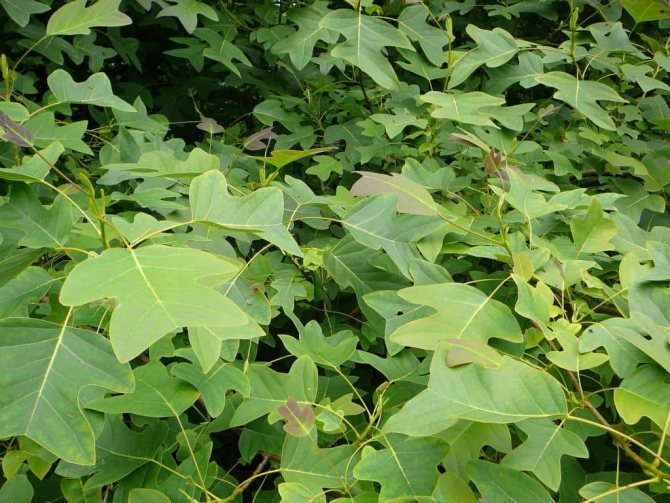

- Tulip Liriodendron (Liriodendron tulipifera)
Deciduous tree up to 30 m high, the diameter of the broad-pyramidal or rounded hipped crown reaches 15 m. The trunk is exceptionally straight to the very top with light gray smooth bark, shallow longitudinal cracks appear with age. Leaves are 4-6-lobed, of an unusual lyre-like shape with a notched apex, 14-15 cm long, on long petioles.


The flowers at the ends of the branches are tulip-like, single, large, up to 6 cm in diameter, the sepals are greenish, bending downward, the petals are yellowish-green with an orange base, slightly fragrant; bloom in May-June after complete foliage. Fruits are complex spiral multi-nuts; ripen in October.
Decorative forms:
- Aureomarginata (up to 20 m high, crown diameter up to 10 m, leaves with a wide golden-yellow border);
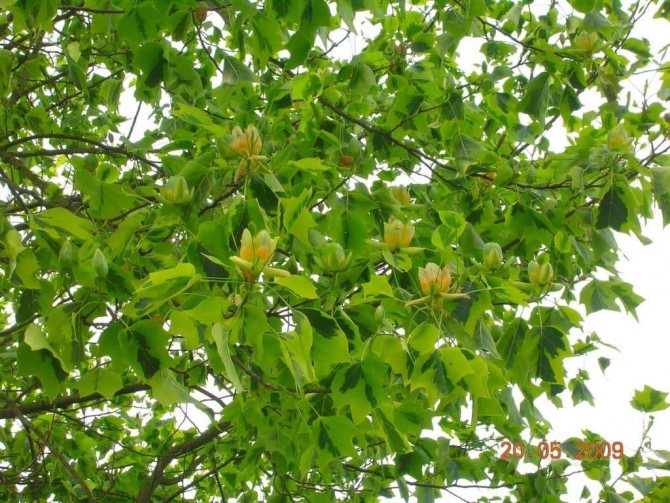

- Fastigiatum (up to 20 m high, with a narrow-conical crown diameter with erect branches up to 8 m).


What is a tulip tree
Liriodendron or tulip tree (lat. Liriodendron) belongs to the oligotypic genus of flowering species of the Magnoliaceae family. Sometimes it is even called a yellow poplar, but this name is not entirely correct, because there is no close relationship between these two plants. During flowering, flowers of fantastic beauty begin to appear on the tree, which can become an enviable decoration of any local area. The flowers are large and at the same time resemble a bud. Blooming liriodendron is capable of exuding a spicy scent
The wood of this bright plant is light and well processed with further polishing. It is often used for the manufacture of high quality plywood and musical instruments. The trunk is straight, massive. The root system has a rod-like appearance. In autumn, the color of the leaves changes. The fruit is cone-shaped oblong - up to 5 cm long.There are three types:
- liriodendron from North America;
- liriodendron from China.
- bell-shaped spatodea;
American view
The tulip tree magnolia of the American variety (Liriodendron tulipifera) stands out for its high decorative qualities, large size, columnar and slender trunk. The crown is high - its height reaches 50 m. The shape of the flowers in the American species is tulip-shaped. Lyre-shaped, highly ornamental and bluish-green leaves are up to 15 cm long - in autumn they acquire spectacular golden tones. It is considered the national symbol of some American states.


Chinese liriodendron
When deciding to grow liriodendron to create an original landscape design, pay attention to the Chinese variety. It grows in the form of a tree, the height of which reaches only 15 m, or a shrub. The climate in the areas of its growth is mild or cool, but always humid. The diameter of the flowers is up to 6 cm, greenish outside and yellow inside. They have no orange spots at the base of the inner side of the petals. The Chinese tree species can grow in all types of fertile soils, but is less common than the American species.
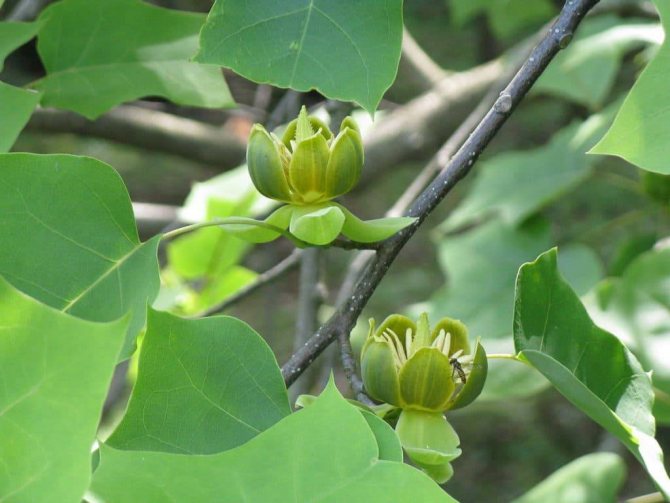

Bell-shaped spatodea
There is also the African tulip tree or spatodea bell-shaped, growing in West Africa, which is sometimes called "ball lightning". Today, due to its climatic stability, it can be found in large areas, but trees are best acclimatized in regions with a temperate climate. It is a seed-propagating plant that gets along well in moist soils. The hybrid species known as Liriodendron tulipifera x L. Chinense grows even faster than either parent.


Botanical description of the plant
Liriodendron tulip is a tall, deciduous tree with deep grooved bark, although the bark of young shoots is smooth. The average height reaches 30 meters, although there are even 50-meter plants. A characteristic feature of the plant is its rapid growth in size. Annual nature can reach 1 m in height, and up to 20 cm in width. This species is durable, because the age of a tulip tree can reach 500 years or more. The trunk diameter with age acquires a size of up to 2 m.
What does it look like
The plant has a massive, columnar trunk, which is covered with light gray bark and beautiful foliage. With age, the bark begins to crack, while exuding a quite pleasant aroma. Trees of this type have a beautifully shaped crown. Young representatives have a pyramidal crown, which eventually turns into a rounded one. Young plants have smooth bark, but with age they acquire a coating with diamond-shaped cracks. As for the branches, they have a brown and dark brown color with shine. The crown gives a spreading and large shadow.
Where grows
When deciding to purchase seedlings of beautifully flowering deciduous tulip plants that take root in moist but well-drained soils, find out where they grow. The plant itself is native to eastern North America. Another species (Liriodendron chinense) is found more naturally in Vietnam and southern China.
This large deciduous tree with brown branches in its plantations spreads widely from the coast of Norway in the north to countries in the south such as Peru, Chile, South Africa, etc. It should be emphasized that when artificially cultivating tulip liriodendron far from the natural place of growth, it does not show aggression towards other representatives of the flora growing nearby.
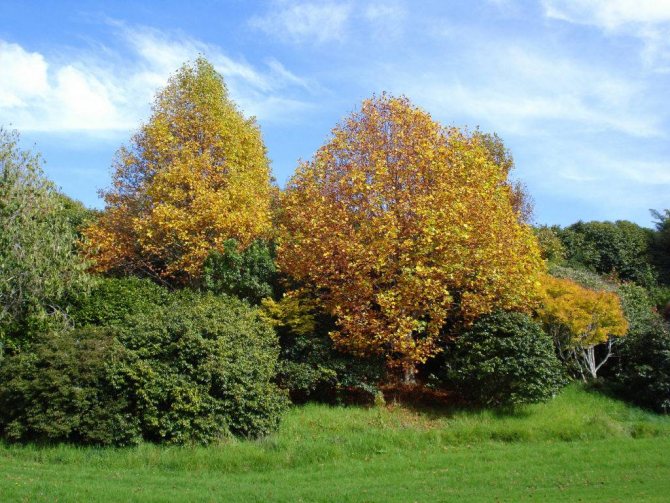

Liriodendron tulip in the suburbs
A tulip plant, with the right attitude, can be acclimatized in humid conditions. Today, the species is being cultivated even in the Moscow region, because it is frost-resistant. The leaves of an exotic plant resemble a lyre, and the first flowering in most cases occurs at the age of 25, although flowers sometimes appear even at the age of 6-7 years. It is not worth using a seedling of unknown origin for sowing in the Central zone and in the north-west of Russia, because they may not be hardy enough.


How to grow a tulip tree at home
Having decided to purchase several copies in order to independently cultivate liriodendron, for example, somewhere in the Sochi subtropics or another region of the Caucasus, first decide on a suitable place. The ideal option would be both black soil and sandy loam soil. A plant is planted with a fast-growing variety with a magnificent crown shape by seeds or cuttings. Remember, liriodendron does not like drafts, so you should not put the pot near the window, entrances and air conditioners. The temperature in summer should be 20-26 degrees, and in winter - at least 10-12 degrees.
Growing this majestic plant in an urban environment requires maintaining an optimal moisture level, which should be around 65%. If it drops slightly, dried leaves may appear, so place a container of water next to the pot. Take up regular spraying of the leaves. The soil should be as nutritious as possible. It is recommended to feed with complex fertilizers twice a year. If you need a transplant into the ground, then do it at any time, excluding the winter period.
Choosing a place on the site
To date, this plant is successfully cultivated in the central black earth regions, besides, tulip trees grow rapidly and multiply by layering, cuttings, seeds and grafting, i.e. in any available way. They bloom in late May - mid June. With regard to the choice of terrain, the fertile layer must lie deep. The tree will thrive in sandy, clayey and moist soil, but well-drained. Stagnation of moisture in the root system, puddles on the surface will lead to the appearance of diseases. Choose a site that is well lit.
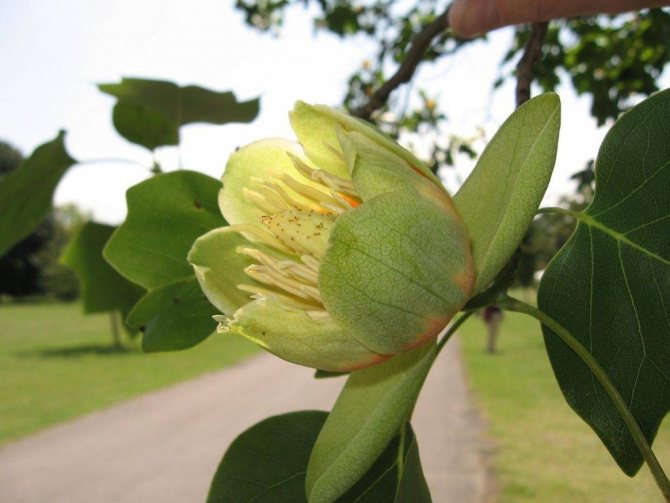

How to plant liriodendron tulipifera
It is best to plant a plant in central Russia in the spring, when the soil is already warmed up. If you bought a seedling with an open root system, then planting is necessary in the coming days. Pre-dip the roots in a container filled with water for 3.5 hours. An instance in a shipping container may last longer. Remember, the plant does not tolerate excess lime. Also, it is not recommended to plant the tree in salty soil. Helpful hints:
- Better not to buy liriodendron if you are not at home often.
- If there are signs of pest infestation, carefully treat the plant with a special solution.
- Monitor the condition of the plant in order to identify and eliminate problems in time, change the conditions of detention.
- Keep Liriodendron away from pets, as in the presence of significant damage to the leaves and roots, it may simply die.
Growing from seeds
Planting tulip tree seeds is easiest to do before winter. For this purpose, prepare a box with soil, soak the seeds for two days using a light pink solution of potassium permanganate or ordinary water, which you change every day 1-2 times. If there is no time, then you can do without soaking. Cover the seeds at a depth of 1.5 centimeters, then water the soil and sketch in a thick layer of leaves. After that, send the box for winter storage in a place without heating, for example, an ordinary plastic greenhouse. Remove foliage from the drawer as it warms.
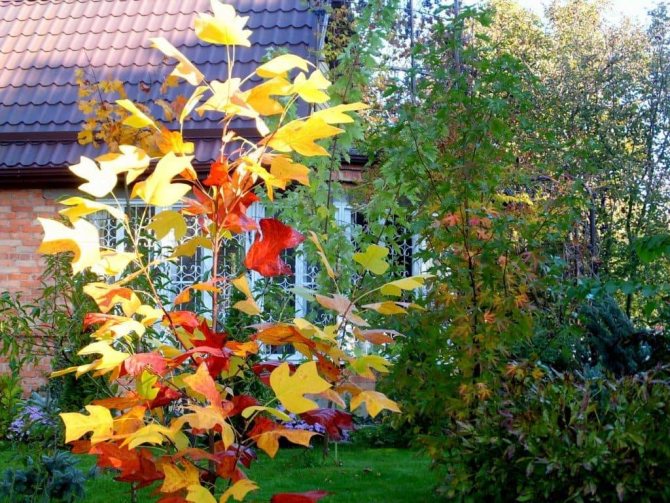

Planting a seedling
Place the future liriodendron somewhere in the sun / partial shade. It is advisable to make a planting hole in 5-7 days - its size depends on the root system of the tree. Inspect all roots before planting to remove any rotted or dried components. A seedling with an open root system should be planted in the coming days. If it is in a container, then the soil must be moistened, and then carefully remove the clod of earth, which is not recommended to be broken during planting. Be sure to lay a crushed stone / broken brick drainage at the bottom of the pit.
Features of care and reproduction
Carefully take care of the planted tulip tree until it is fully ripe. Water often, but in moderation, or the root system may rot. These recommendations are especially relevant in the first two years of a young tree's life. Use warm water - it is best to heat it in a barrel to ambient temperature. In addition, caring for this ornamental lyrodendron requires proper fertilization and winter preparation. When young, it tolerates pruning well, which can help shape properly.
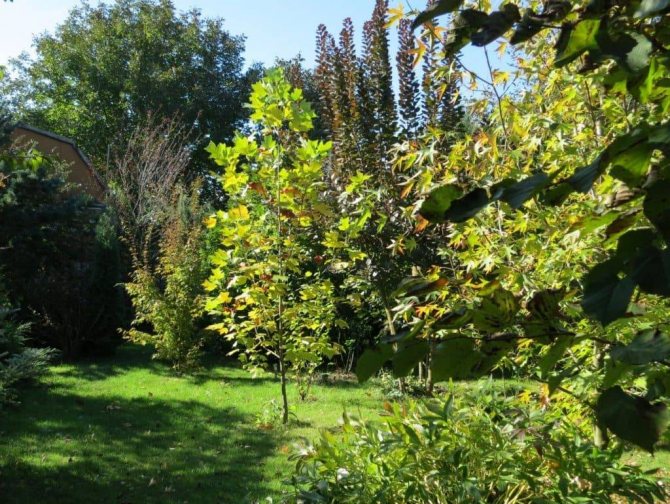

How to properly water a tulip tree
In regions with dry and hot summers, the tree will not grow very well. To revitalize the process, irrigate the crown every day from a special nozzle on the hose. Perform the described procedure after 17:00, i.e. when the sun is no longer so active. With a small amount of precipitation and during a hot summer, the plant needs not only regular watering, but also protection from the wind, mulching. Watering should be regular without overdrying and overflowing.
Fertilization
After planting, in addition to watering, you need to do fertilization. It is recommended to start feeding an exotic plant in the second year of life. In early spring, it is recommended to use mineral formulations as a top dressing, the nitrogen content of which is increased. For the second feeding, you should use a fertilizer with a potassium-phosphorus composition.
Preparing for winter
Care when growing a tulip tree must be competent and well thought out. The shelter must be removed in a timely manner so that the tree does not come out under the rays of the spring sun. You need to monitor the weather forecast regularly, because return frosts can be extremely dangerous and destructive for a delicate exotic tree. Despite the fact that it is frost-hardy, young seedlings are very susceptible to weather conditions, so they require attention and care.
In autumn, after cleaning the area from debris and fallen leaves, the layer of mulch must be renewed - the thickness is about 10-12 cm. Fragile young plants need to be additionally insulated. For this purpose, make a kind of cap of non-woven fabric / burlap folded in 2-3 layers. The branches of the tree must be pressed against the trunk, tied with twine, then put on a cap on them and fixed using a rope. In addition, you can put spruce branches around the tree, throwing snow on them.
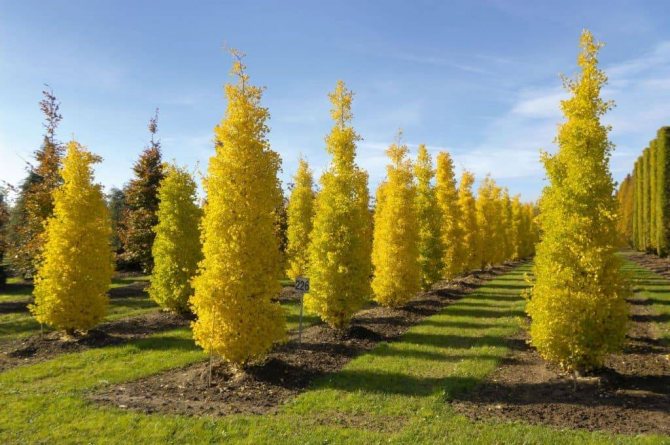

alena-
Other articles about colors:
Growing liriodendron at home
Planting liriodendron is complicated by the condition that the seeds that fall off after the completion of fruit ripening remain capable of germination only during the first few days. In this regard, it is advisable to sow only young seeds for germination, preferably not older than the first two days.
How to properly plant a liriodendron
A tulip tree is planted in open ground in two ways:
- self-collected seeds,
- cuttings.
When disembarking or replanting tulip magnolia in a new place of "residence", it takes root without any difficulties, but nevertheless this process may take some time. After all, it is necessary that certain conditions be met. In particular, this plant requires a favorable soil for it.
One significant plus is the ability to easily tolerate severe temperature fluctuations and can maintain its vitality and splendor flowering even when temperatures drop below 30 degrees. This ability makes it possible to grow Liriodendron in the middle lane, in particular, in the suburbs.
Since this tree is very freedom-loving, it should not be planted in small gardens... It is advisable to plant this plant in spacious areas so that the tulip magnolia grows and develops fully.It is necessary that the soil for the growth of a tulip tree is well-drained and fertile, and the fertile layer should be located as deep as possible, since the root system of this plant has a rod-like appearance.
In the United States, entire fields of liriodendron are often planted to produce strong and light wood that is easily processed on an industrial scale. In some states, this plant is a symbol. In this regard, the tulip tree receives a lot of attention there.
Tulip Liriodendron plant with a description and photo - how to plant, grow and care
Have you decided to start growing ornamental plants? Then pay attention to the tulip tree, the planting and cultivation of which in the Moscow region or other region of the country requires a competent and serious approach. The plant itself is unique in its kind. They can effectively decorate any garden or site. The peculiarity lies in the fact that this plant is able to grow in almost any conditions, and such a tree is resistant to frost down to -30 degrees. Highlanders consider liriodendron sacred.
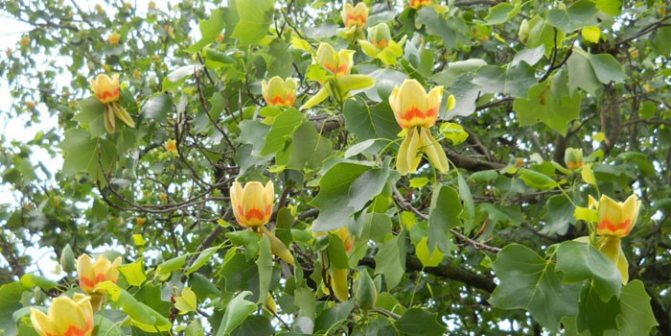

Care and reproduction
Most often used propagation with seedsthat are in the fruit. When the fruit ripens, it opens and falls, throwing out lionfish. The lionfish is the place where the tetrahedral seed is located. It is this that makes it possible to germinate new shoots, to take root in the soil.
The tulip tree prefers abundant moisture, so it needs to be watered more often. But you should not be too zealous either, because an excess of water can provoke the beginning of the process of decay of the root system, which leads to the death of the plant. The number and volume of watering should be in accordance with the age of the tree: the older it is, the more abundant and more often waterings should be. But if the season is not dry, then you should not exceed the standard watering, sometimes you can do with natural soil moisture through precipitation.
Seed reproduction
Most summer residents practice the seed propagation method of the magnolia tulip tree. Planting from seeds is considered the easiest and most productive, while in order to avoid problems, you need to listen to the advice of experienced colleagues. It is customary to carry out the procedure in the fall, before winter. In this case, a box with a soil substrate is preliminarily prepared and the seeds are soaked in a solution of potassium permanganate or ordinary water. It is important to change the liquid in the container twice daily.
The planting material must be deepened by 1.5 centimeters, and then the soil must be poured and covered with a thick layer of leaves. In the end, it remains to send the box for winter storage to a cool place, for example, an ordinary plastic greenhouse. As it warms, the foliage should be removed from the container.
The grown seedling is best placed in a sunny or slightly shaded place, while the preparation of the planting recess should be done 5-7 days before planting. The size of such a pit is determined by the size of the root system.
Before filling the seedling, you need to make sure that the roots are healthy enough and do not have pronounced defects.
Also, the bottom of the pit should be laid out with a drainage layer, which consists of rubble or broken bricks.
How and when liriodendron blooms
Liriodendron considered one of the most abundantly and brightly flowering trees... Its flowering occurs, as a rule, at the end of May or the beginning of June, and then flowers of fantastic beauty unfold on the branches, which cover the branches with large open buds. They are very similar to tulip buds. After the opening of the petals, a bright orange pedicel is found, which protrudes from the middle of the receptacle.
With the flowering period in the places where the tulip tree grows, a dizzying fresh scent appears, spreading throughout the district.During this period, the plant pleases the eye with yellow, orange, green and white flowers. It should be noted that flowering in trees begins only ten to eleven years after planting. Yes, you will have to wait, but this is what makes the appearance of the first flowers especially long-awaited and valuable.
Proper plant care
Care for a newly planted seedling should be as careful as possible until the trunk is fully formed and the plant ripens. Particular attention should be paid to watering - it should be done frequently but in moderation. Otherwise, the root system may start to rot.
Such recommendations are especially relevant for the first two years of life of a young tulip tree. It is better to heat the liquid used for irrigation in a barrel to ambient temperature. An important feature of proper care is complex feeding and preparation for winter.
What the paulownia Adam's tree looks like: a description of the species
At a young age, the tree easily tolerates pruning measures, which play an important role in crown formation.
If the cultivation takes place in a hot, arid climate, then the productivity of growth will be significantly reduced. Daily irrigation of the crown with a special hose nozzle helps to solve the problem. The action should be performed after 17 hours, since at this time the activity of the sun is no longer as aggressive as at lunchtime. Low rainfall and hot summer weather are a significant reason for frequent watering, as well as protecting crops from wind. Seasonal soil mulching may become a necessary requirement.


After successful planting, it is necessary to apply complex fertilizers to the soil. Feeding activities begin from the second year of life, while at an early age, mineral compositions with a rich nitrogen content will be effective. The second top dressing is performed with potassium-phosphorus dressings.
Preparation for winter is performed from autumn, before the first frost begins. Following the recommendations increases the chances of successful growth and tree formation in a wide variety of conditions.
What does a tulip tree look like? Enchanting mystery of nature
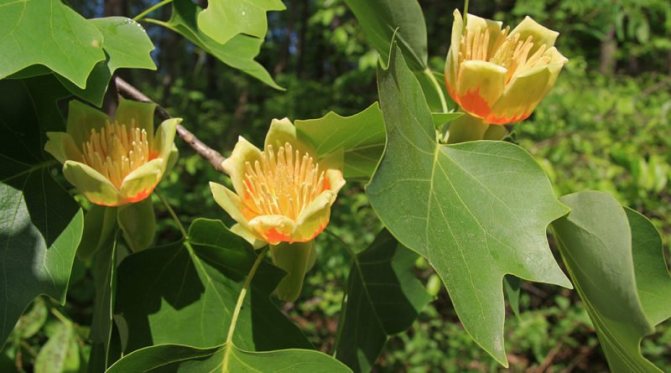

Many people adore spring flowers like tulips. However, few people know that they can grow on trees, which are called respectively - the tulip tree, or lijdendron tulipitera. The flowering of this plant is like a fairy tale.
Liriodedrone belongs to the magnoliaceae family and is a fairly tall tree, some species exceed 60 m in height. The plant originally grew in North America. In our country, it grows mainly on the shores of the Black Sea, in Krasnodar (Golovinka village), you can often find a tulip tree in Sochi as a decorating element of landscape design.
Also, residents of one of the villages of the Kirov region know about this plant. Vorzel and tulip tree are practically synonyms. You can also find it in the Moscow region in various botanical gardens.
HUMAN USE OF TULIP TREES
Tulip trees are grown for both decorative and industrial wood uses. In reference books on the characteristics of wood of different types of trees, their wood is called "white tree" or "white canary tree". It is used for the manufacture of bodies for musical instruments, radios, containers, in paper production and for other purposes where light, easy-to-handle and polish wood is needed. Native Americans used the trunks of tulip trees to make canoe boats. The structure of the wood and the shape of the trunk are ideal for this. Lyran is the most melliferous plant in eastern North America. The plant not only has a large number of melliferous flowers on one copy, each of the lyran flowers gives off a lot of valuable and aromatic nectar
Description of appearance
In nature, the tulip tree grows in regions with a humid and warm climate, while some species of this plant can be safely attributed to the category of long-livers. Scientists studying lyriodedrone have come across specimens up to five hundred years old. This is because lijdendron tulipitera can grow up to 100 cm per year.
The tree has a fairly thick layer, which is covered with gray bark, it exudes a spicy and slightly tart aroma.
A young tree, as shown in many photos, has a smooth crown of a light gray or light greenish tint. A more mature plant has a spreading, slightly uneven crown. But, despite this, as a rule, it does not require special adjustments.
When describing branches, it is appropriate to use the term "shiny". If the twig is slightly broken, then you can feel a slightly tart, spicy smell. The leaves are quite wide, green or light green, which in the fall, like all ordinary trees, acquire a yellow tint.
The tulip tree plant blooms in the summer, but the first flowering occurs on average only 25 years after planting.
Of course, you can see how it looks in the photo, but if you visit the guest house "At the Tulip Tree", you will see with your own eyes how the tulip tree blooms in Golovinka.
Botanical description of the plant
Liriodendron tulip is a tall, deciduous tree with deep grooved bark, although the bark of young shoots is smooth. The average height reaches 30 meters, although there are even 50-meter plants. A characteristic feature of the plant is its rapid growth in size. Annual nature can reach 1 m in height and up to 20 cm in width. This species is durable, because the age of a tulip tree can reach 500 years or more. The trunk diameter with age acquires a size of up to 2 m.
What does it look like
The plant has a massive, columnar trunk, which is covered with light gray bark and beautiful foliage. With age, the bark begins to crack, while exuding a quite pleasant aroma. Trees of this type have a beautifully shaped crown. Young representatives have a pyramidal crown, which eventually turns into a rounded one. Young plants have smooth bark, but with age they acquire a coating with diamond-shaped cracks. As for the branches, they have a brown and dark brown color with shine. The crown gives a spreading and large shadow.
Tulip tree - photo
Planting and growing
It is quite possible to grow a tulip tree at home, but if there is enough space for this on the site, for example, as in a guest house and Golovinka.
The plant propagates from seeds, but is transplanted by cuttings or adult seedlings. In this case, the safety of the root system is of great importance, as well as the choice of an appropriate place.
For example, the statodeya, or the African tulip tree, prefers large, well-lit areas with fertilized, moist soil.
The site should be either sandy or clayey, but always perfectly drained. The transplant can be carried out during the entire warm season. But you always need to ensure that during subsequent watering, stagnation of the root system and puddles around the trunk do not form. Otherwise, it can lead to disease of the entire tree.
It should be noted separately that in the winter cold, when the thermometer drops to minus 25 degrees, the tree feels very comfortable, and at minus 30 degrees frostbite of the branches can already occur. However, this behavior is characteristic of all members of the magnolia family.
How to plant liriodendron tulipifera
It is best to plant a plant in central Russia in the spring, when the soil is already warmed up. If you bought a seedling with an open root system, then planting is necessary in the coming days. Pre-dip the roots in a container filled with water for 3.5 hours. An instance in a shipping container may last longer. Remember, the plant does not tolerate excess lime. Also, it is not recommended to plant the tree in salty soil. Helpful hints:
- Better not to buy liriodendron if you are not at home often.
- If there are signs of pest infestation, carefully treat the plant with a special solution.
- Monitor the condition of the plant in order to identify and eliminate problems in time, change the conditions of detention.
- Keep Liriodendron away from pets, as in the presence of significant damage to the leaves and roots, it may simply die.
Growing from seeds
Planting tulip tree seeds is easiest to do before winter. For this purpose, prepare a box with soil, soak the seeds for two days using a light pink solution of potassium permanganate or ordinary water, which you change every day 1-2 times. If there is no time, then you can do without soaking. Cover the seeds at a depth of 1.5 centimeters, then water the soil and sketch in a thick layer of leaves. After that, send the box for winter storage in a place without heating, for example, an ordinary plastic greenhouse. Remove foliage from the drawer as it warms.
Planting a seedling
Place the future liriodendron somewhere in the sun / partial shade. It is advisable to make a planting hole in 5-7 days - its size depends on the root system of the tree. Inspect all roots before planting to remove any rotted or dried components. A seedling with an open root system should be planted in the coming days. If it is in a container, then the soil must be moistened, and then carefully remove the clod of earth, which is not recommended to be broken during planting. Be sure to lay a crushed stone / broken brick drainage at the bottom of the pit.
Tulip tree in Golovinka (Sochi): general description of the natural monument
Have you ever seen tulips growing on the branches of a huge tree? If not, then feel free to go to the Black Sea coast, to the Lazarevsky district.
The tulip tree in Golovinka amazes not only with its beauty, but also with its size. Its height is 35 meters, and the crown diameter is 27 meters. Taking a photo of this giant is not so easy: you have to move as far as possible! The Golovinsky lyran has a huge trunk: almost 2.5 meters in diameter. It will take at least eight adults to fully embrace it.


In the immediate vicinity of the natural monument, there are souvenir shops where tourists can buy magnets and commemorative coins depicting a tree giant.
Flowering tree
Liriodendrons begin to bloom in early May. In cold years, the buds bloom later: in the middle or at the end of the month. Flowers are located at the tops of the shoots. Corollas almost always look, which gives them a tulip-like appearance. There are relatively few buds on the tree: one per branch. Flowering continues until mid-June.
With a sufficient amount of moisture and nutrients in the soil, the buds are laid 6-7 years after the seedlings are planted in the open ground. In the early years, they are formed a little, they may not fully open. Flowering becomes more abundant with age. If buds do not appear for many years or there are very few of them, the growing conditions need to be improved. In the spring, you can water the tree with a mullein solution, increase the proportion of applied phosphorus and potassium fertilizers.
Although the buds are quite large, capable of reaching 8–10 cm, corollas can be smaller in temperate climates.
The sweetish, pleasant aroma that appears during flowering attracts bees and other insects. At home, the tulip tree is an excellent honey plant.
Where can I get it?
Where can I get a tulip tree? Of course, today you can find almost anything in flower shops.But when buying from one of them, there is a risk of stumbling upon low-quality or expired seeds, which, of course, will not sprout.
Yes, you can buy an already growing tree, but in store conditions, plants are often sprayed and "stuffed" with all kinds of chemicals. And once in your house, the spatodea may simply die. So it is best to contact experienced flower growers and purchase seeds or seedlings from them.
How to grow?
How to grow a tulip tree? Despite the fact that in nature it grows in tropical forests and calmly survives any droughts, this plant simply needs to be provided with proper care, without it it will die.


It is important to choose the right place, provide adequate lighting and optimal humidity. But everything is worth writing in more detail.
Surprisingly, the tulip tree growing in sunny Africa does not tolerate sunlight and responds to such exposure with yellowing or falling leaves. The ideal option is partial shade. Diffused light is also acceptable.
The tulip tree does not like drafts, so it is not recommended to place it near entrances or air conditioners. The location next to heating devices is also unacceptable. Putting the pot by the window is definitely not worth it.
In addition, it is advisable to choose the north or west side of the apartment or house. It is not recommended to move the spatodea to the balcony, but it can be placed in the garden by choosing a shady area.
Temperature
When creating optimal conditions for growing a tulip tree, pay special attention to temperature. So, in the summer, it should be about 20-26 degrees, and in winter the temperature can drop to 10-12 degrees.


Sharp changes are disastrous, as is a significant decrease. So, at 3-5 degrees, all processes begin to slow down, at 0, the aerial part of the spatodea perishes, and at -5, the roots also perish. But if they are slightly damaged, then after freezing they can recover.
Proper care involves maintaining optimal humidity, which should be approximately 65%. With a significant decrease in it, the plant may begin to dry out and lose leaves. If the humidity is insufficient, then a container filled with water can be placed next to the pot. Also in this case, regular spraying of the leaves will be required.
Correct soil
A beautiful tulip tree can grow in almost any soil, including fresh ones. But the more nutritious the soil is, the higher the growth rate will be. In addition, the enriched soil stimulates flowering as well as an increase in the number and size of leaves.
Read also: Proper care of daffodils after flowering
How to water?


Watering should be carried out regularly, since drying out of the earthy clod will inevitably lead to drying out and falling of the leaves, and then to the death of the plant. But moisture should not stagnate either, this can provoke root decay. The humidity should be constantly monitored so that the African tulip tree delights with its flowers and leaves.
Spatodea needs feeding during the period of active growth, that is, in spring and summer. You can use mineral fertilizers in combination with organic fertilizers. You can feed the tulip tree once every one or two weeks.
Reproduction
Reproduction of spatodea at home can be done in several ways. The first is grafting. But you should use young shoots without bark. The second method is reproduction using root shoots. The roots of the tulip tree have unique properties and are able to recover even after freezing, so that by planting a part of them, you can see the shoot after a certain time.
The most proven and effective breeding method is seed growing.
First, it is recommended to place them in a cotton swab moistened with water for a couple of days. Humidity must be controlled and maintained.Next, you can move the seeds into the ground, while not forgetting to provide good drainage.
The soil should be loose and moderately moist. Next, the container should be covered with a film or glass and placed in a warm place (in winter, additional moderate heating can be provided, this will accelerate germination). The sprouts will appear in about a few weeks. The container can now be placed in the selected place. It is undesirable to transplant a spatodea in the coming year.
Growing conditions
- A place. The main criterion when choosing a place for planting a tulip tree should be good illumination, since in shady places the flowering of the tree will be very scarce. And the plant should be protected from drafts and harsh winds. Considering all these factors, the place should be selected immediately, since the plant has very brittle roots and it categorically cannot stand a transplant.
- Priming. Sandy or clayey soil is quite suitable for a plant, the main requirement for it is good drainage, since when moisture stagnates in the root system, decay processes begin and the chances of various infections attaching significantly increase.
Views
There are three types of tulip trees in nature.
Liriodendron tulip (American) (Liriodendron tulipifera Fastigiatum)


Liriodendron tulip
The American magnolia differs from its congeners in its large size, has a column-shaped trunk. The creamy flowers are shaped like tulips, with an orange tint in the middle. During the flowering of the tree, the aroma of chocolate spreads around the area. The lyre-shaped leaves, which are 20 cm long and 25 cm wide, have a bluish-green hue, which becomes golden by autumn. A fast-growing tree prefers to grow in a warm, humid climate; it does not tolerate frost. In some American states, liriodendron is considered a national symbol.
Liriodendron chinense
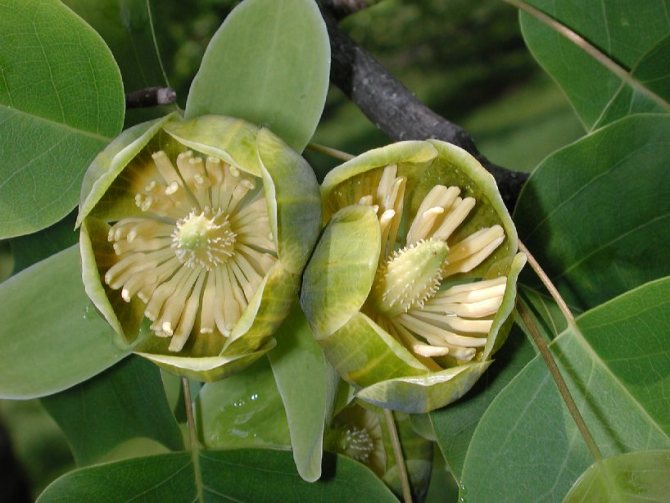

Liriodendron chinense
To create an original landscape, you should pay attention to the Chinese variety of liriodendron. A mild or cool climate is considered favorable for growth, which, moreover, must be humid. The height of the tree does not exceed 15 meters.
The blossoming tulip-shaped flowers have a diameter of about 6 cm. Their color is yellow on the inside, without orange spots, on the outside they are greenish. This species prefers any fertile soil for growth.
Spathodea campanulate (Spathodea campanulata)


Spathodea campanulate (Spathodea campanulata)
This plant is also popularly called the tulip tree for the similarity of its flowers to the flowers of the liriodendron. In fact, the spatodea is not a relative of them and belongs to the Bignoniev family.
The bell-shaped spatodea comes from West Africa. There she received the names "ball lightning" or "tree-fountain" for its bright color and abundant flowering. This species has flooded large African territories, since the temperate climate is favorable for its growth, and is included in the list of the most dangerous invasive species. The seeds of the plant germinate well on moist soil. Bright red flowers bloom on the tops of branches, their number in the crown can reach one hundred pieces.
general information
Liriodendron, or tulip tree, is a representative of an oligotypic genus of flowering plants from the Magnoliaceae family. Often it is called yellow poplar, although this is not entirely correct, because the species are very different from each other and have no related similarities. At the flowering stage, the tree is covered with fantastically beautiful flowers, which become a bright decoration of the site. The size of the flowers is large enough, while they are somewhat similar to a bud. The flowering of the tulip tree is accompanied by a special spicy scent that cannot be confused with others.
The cultivation of tulip liriodendron in the Moscow region is of interest to many residents of this region, which is not surprising.
An invaluable advantage of the plant is the low weight of wood, therefore it is often used as a basis for elite plywood and musical instruments. As it grows, the trunk of the tree becomes straight and massive; the rhizome has a pivotal appearance. In the autumn, the color begins to change, and the ripening fruit takes on a cone-shaped oblong shape. Its length reaches 5 centimeters. Scientists distinguish three types of plants:
- North American liriodendron.
- Chinese.
- Bell-shaped spatodea.
Application
In Europe, tulip liriodendron is an ornamental plant. A dense crown with spectacular buds, good frost resistance, fast growth and lack of aggressiveness towards native species are very much appreciated by gardeners. Trees are planted in parks and squares with whole alleys. The foliage of adult specimens creates a thick shade, protects from the summer sun, and helps to purify the surrounding air.
In gardens and home gardens, lyran is an exotic element of landscape design.
Tree legends
The tulip tree in the village of Golovinka attracts tourists not only with its size, but also with numerous legends. So, according to one of them, the tree has a huge and inexhaustible supply of vital energy. You can get a particle of this tree power by touching the lyran with your back. In this position, you need to stand by the tree for several minutes.
Another interesting legend is associated with a hollow, which cannot be overlooked on the trunk of a tulip tree. It is believed that this hollow is capable of fulfilling human desires. But on one condition: having made a wish, you must definitely hit it with a coin. If you miss - the wish will not come true, and if you get there, expect it to be fulfilled as soon as possible!
Preparing for winter
An adult tulip tree is characterized by a fairly good frost resistance (it tolerates frosts up to 23-25 degrees quite normally), but it is better to cover young plants for the winter. First of all, you need to replace the mulch with a thick layer of new one.
Young trees are neatly bent and fixed in this position, and a thick burlap is put on top and tied so that it does not sleep in adverse weather conditions. It will be necessary not to forget about it at the beginning of spring, when the sun begins to warm up - the plant can simply rot. You can also build a shelter from branches by placing them around a tree and pouring a lot of snow on them.
Characteristics of existing species
If we talk about the American variety, then it is famous for its excellent decorative properties, growing to an impressive size and having a columnar slender trunk. The height of the crown can reach 50 meters if the conditions of detention correspond to the required ones. In their shape, the flowers are similar to tulip, and the leaves resemble a musical instrument lyre.
The color of the inflorescences is represented by bluish, green and light shades. Their length is about 15 centimeters. In the autumn, the leaves turn golden. By the way, the plant is considered the national symbol of individual states.
As for the Chinese liriodendron, it is in great demand among fans of exotic vegetation with an unpretentious character and unique appearance. As it grows, the plant turns into a powerful tree up to 15 meters high. Sometimes it takes the form of a bush, expanding in width.
Given the climatic conditions in which the Chinese species grows, it is necessary to provide it with high humidity when kept at home. For reproduction, the seed method is used, and the maximum percentage of germination is observed on wet soil. The fastest growing rate is seen in hybrid varieties.
Possible problems
Problems can arise only due to unscrupulous care of a perennial.
- If the climate is hot and dry, the leaves of the liriodendron darken, then dry out. It is required to increase watering and spray the tree in the evenings;
- If the light is too bright in summer, foliage can turn yellow. The plant needs to be shaded;
- The color of the leaves can "speak" of a lack of nutrients. If the foliage has become pale, then the plant needs feeding.
Tulip lyran is more capricious when grown indoors. You need to follow some recommendations:
- protect the tree from pets so that they do not damage it;
- feed the plant in a timely manner;
- when pests appear, immediately treat them with special means.
If the owner of the tulip tree is often absent at home, then it is better to refuse to grow this exotic at home. The tulip tree does not like transplants and does not tolerate them well. It is better to immediately find a suitable place for it, planting it for permanent cultivation.





